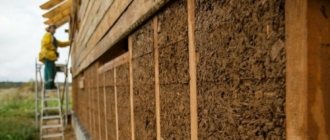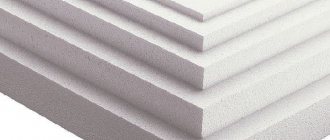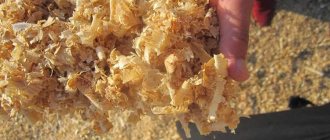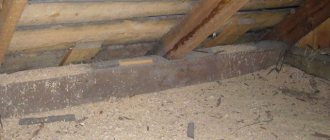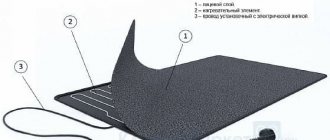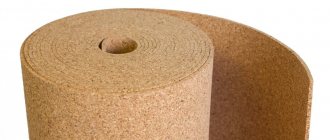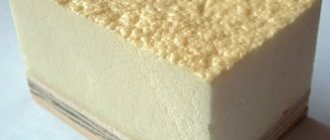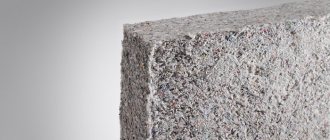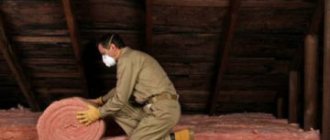Builders with significant experience in the field of roof insulation argue that in order to insulate cold-type roofing structures, it is necessary to use backfill insulation. This insulation is used when arranging the attic floor and is poured into the space between the joists. About 20% of heat loss occurs due to poorly insulated roofing, and that is why such a measure is not superfluous. The vast majority of builders agree that thermal insulation must be installed in any heated room. But if we consider the issue of choosing a material for thermal insulation, then such solidarity is not observed between builders: some of them use materials created using modern technologies, while others prefer to insulate the roof with sawdust. In this article you will learn how to use wood waste to optimize the temperature regime in your home.
Preparatory work
How to insulate a ceiling with sawdust in a private house?
Whatever method is chosen, preliminary preparation of the wooden base is required. Initially, the elements on the ceiling are processed. As a rule, during construction they use material that has already undergone appropriate processing. However, in some cases this procedure is skipped. Then you need to do it yourself. For processing, it is recommended to choose drugs from the same brand. Some manufacturers offer products that perform several functions at once, for example, protect against fire and high temperatures, prevent rotting and insect damage. The bathhouse must be treated with special products that are resistant to high humidity and high temperature.
We suggest you read: How long does fireclay clay take to dry?
After processing and drying of wooden structures and ceilings, the substrate is laid.
Initially, all gaps and cracks should be sealed. To do this, use polyurethane foam and acrylic sealant. Large cracks are treated with foam. Gaps and joints are sealed with sealant. It is allowed to use bitumen mastic, but not for finishing the ceiling of a bathhouse. This is due to the low resistance of the material to high temperatures.
You need to seal not only the holes in the wooden ceiling, but also in the roof itself. This increases the thermal insulation properties and eliminates the impact of external factors on the internal elements of the roof.
An excellent and inexpensive option is to lay cardboard. It can be any type of material. The main condition is that the cardboard must be dry. The sheets are laid directly on the ceiling, with an overlap of 15-20 cm on each other. If the cardboard is thin, then it should be placed in 2-3 layers. The joints are fastened with staples. The perimeter of the junction of cardboard and walls is treated with polyurethane foam or sealant.
PVC film is often used as a backing. It is also laid with an overlap of 10-15 cm, and additionally secured with staples using a stapler. The edges of the film around the perimeter should extend onto the walls/roof by 10-15 cm.
Hemming of floor beams
Work related to how to insulate a ceiling in a private household with sawdust should begin with filing the ceiling; it is performed in a certain sequence:
- Prepare boards approximately 2.5-3 centimeters thick - this parameter depends on the distance between the beams. It is desirable that the lumber be tongue-and-groove or with a quarter, and certainly planed and dry, even if their cost is higher than unplaned edged products.
- On top of the assembled vapor barrier layer, boards are attached solidly with nails 10 centimeters deep or screwed with screws 5-6 centimeters long, 2 pieces at each fixation point. In this case, the nails are driven in at an angle relative to the wooden plane. It is necessary to ensure that the direction of the adjacent nails driven in does not coincide, and then the fastening will be strong and most reliable.
- Before starting installation work, boards and beams must be treated with special compounds - antiseptic and fire retardant. This will protect the wood material from fungus and various pests, and will also help reduce its flammability.
Alternative options for thermal insulation with sawdust
If the ceiling is insulated using sawdust, it is extremely important to carefully seal all the cracks on the surface. Polyurethane foam can easily solve this problem.
There is more than one option for installing a vapor barrier layer using sawdust. It is possible to use only wood shavings, but there are methods that involve preparing mixtures of sawdust with other materials for construction.
The following methods are very popular:
- pour clean sawdust onto the insulated surface;
- the use of additives such as lime or sawdust with cement along with sawdust;
- inclusion of components such as clay and lime in the mixture.
Elimination of flowability
Without the proper approach, the heat-insulating backfill made from sawdust will turn out to be loose. Over time, this will lead to shrinkage of the insulation materials. The system will lose the necessary qualities and begin to transmit heat.
The problem is solved through various additives (clay, cement, gypsum), which convert the composition into a solid type aggregate. You can mix 85% sawdust, 5% gypsum, 10% fluff lime and water to dissolve the gypsum. In this case, wet sawdust is used. They do not require special drying. First, the material is mixed with lime.
Plaster is then added, followed by a quick installation. Since gypsum compositions set in a very short time, the mixture is prepared in small portions. Otherwise, it may freeze before installing the insulation system.
A mixture of sawdust and gypsum prevents friability.
The resulting mass has a porous structure. As a result, the material acquires heat-shielding properties. Shrinkage of the insulation system is eliminated, the thermal insulation qualities are preserved, and the service life is extended.
Instead of fluff lime, it is permissible to use lime paste. You need to take twice as much of this material. The volume of water, on the contrary, decreases.
Insulation process technology
For effective thermal insulation of the roof with sawdust, it is necessary to carry out high-quality preparatory work.
Wood shavings must be treated with specialized preparations aimed at protecting against fire and rodents. The process of insulating a cold attic with sawdust is as follows:
- The wiring is insulated and hidden in metal pipe casings, and the remaining exhaust communications are either covered with crushed stone or covered with fire-resistant seals.
- Using wood chips and wooden boards, formwork is laid on the subfloor.
- To prevent the appearance of moisture in the sawdust, a profiled membrane is spread on the floor (for waterproofing) and secured with a construction stapler.
- A thermal insulation mixture (sawdust with clay or lime) is laid out on the surface of the waterproofing material to a layer of 30 centimeters, pre-mixed in small portions. When using a dry mixture, it must be compacted.
- The insulation is carefully leveled and left for 2-3 weeks to completely dry and shrink.
- When the insulation layer has completely dried, it is again covered with waterproofing, which is secured with a stapler.
- After all the work has been done, the flat roof is laid.
The process of insulating an attic using a mixture of sawdust and clay.
How to choose suitable sawdust for insulation?
Both small and large sawdust are suitable for protecting a house from freezing, but the former are slightly warmer than the latter. You can also use wood chips and shavings. Both are cooler than sawdust, and the difference is on average 15-20%.
At the end of the topic, we note that it is advisable to dry the sawdust well before filling it. To do this, they are scattered under a canopy in a layer of no more than 50 cm and raked a couple of times a day for better ventilation.
Softwood sawdust most effectively resists rotting due to its high resin content - a natural antiseptic
About sawdust as a material
Today, a variety of materials are used for thermal insulation of roofs, wall structures, floors, attics or interfloor ceilings. But sawdust, slag and shavings are considered the cheapest raw materials for creating an insulation system. Due to their low price, they are widely used in construction.
Sawdust is the cheapest option for insulating an attic.
Opponents of sawdust put forward arguments that waste from the wood processing industry has outlived its usefulness. But our grandfathers and great-grandfathers often covered roofs or walls with them, and many structures still exist. Moreover, the thermal insulation characteristics have not deteriorated, despite the impressive service life. The main advantages of using sawdust as insulation:
- availability;
- environmental friendliness;
- durability;
- ease of installation.
Pros and cons of sawdust insulation
Sawdust - highly environmentally friendly insulation
Sawdust as insulation can be used to work with any elements of the house, including attic floors, floors, walls, cellars and much more. This material must be subjected to special processing; only in this case will it fit into the complex of construction works
All electrical cables crossing layers of insulation must be insulated; great attention is also paid to the thermal insulation of chimney pipes in those places where they pass through attic floors
Sawdust, used as ceiling insulation or for other parts of the room, is divided into several varieties depending on the type of wood. The best choice is oak sawdust, which has low hygroscopicity when compared with analogues of other types of wood. They are least susceptible to the spread of rot and are not able to swell when exposed to water. In addition to oak, waste from coniferous trees, such as larch, pine or spruce, is suitable for thermal insulation.
The list of the main advantages of the material includes:
- increased level of environmental friendliness, since sawdust does not emit toxins;
- very low price;
- the ability to use the material in bulk or in another state, for example, in combination with natural or synthetic materials.
Criterias of choice
It is possible to provide high-quality thermal insulation for a room if you choose the right insulation materials. Clay resembles ordinary plasticine - it is plastic. For construction work, it is best to use red clay: it is more pliable, hardens faster, and absorbs less liquid. If such material is not available, you can use other varieties (for example, white). This will not affect the final result, but the finished surface will subsequently have to be looked after more carefully.
Red clay is best suited for insulation work because it has high plasticity and minimally absorbs moisture Source kamtehnopark.ru
Insulation under heating structures
Installation of the elements of the “warm floor” system can be carried out on any type of base, if before this a support was made in the form of a screed and an insulating layer was laid on it. A solution of sawdust with any binding material (recommended proportions is 3:1) solves both problems simultaneously: the frozen mixture becomes a strong support; The high sawdust content allows the screed to be considered a heat insulator. The strongest screed will be made from cement and sawdust.
Tape-type heaters are laid on top of the insulating layer. For other elements (pipes, cables), channels are made in advance or filled with a second screed made of heat-conducting material.
Types of sawdust products
You can insulate the floor not just with sawdust, but with insulating materials created using them.
Sawdust granules
They are obtained by mixing sawdust with glue. Antiseptic additives must be included in the mixture. The granules retain the thermal insulation properties of ordinary sawdust, but have better resistance to rotting and are difficult to ignite.
Sawdust granules
Sawdust concrete
These are ready-made blocks of insulation obtained by mixing sawdust with sand and cement in different proportions. It is used for construction purposes, but for floor insulation it is better to take blocks with a high sawdust content. They are less durable, but their thermal conductivity is lower.
Sawdust concrete blocks
Arbolit
To make arbolite blocks, large wood chips are used, mixed with cement mortar without adding sand.
Arbolit
Recommendations for ceiling insulation
If you decide to insulate using sawdust material, you should take into account the peculiarities of working with it. It is necessary to select chips of appropriate quality and carefully prepare them before laying.
It is first necessary to carry out a number of operations aimed at improving the protection of wooden elements from fire and rotting. This is due to the fact that sawdust, also a derivative of the woodworking industry, is a combustible material and is susceptible to fungi and rot.
Insulation with wood shavings can be carried out in two ways: dry and wet. In the first case, the usual filling with dry sawdust occurs. Insulating the ceiling in a bathhouse is not recommended using this method. Such thermal insulation is still flammable. It is better to use a clay-sawdust solution
It doesn't matter which method is chosen. Insulate your house correctly, and then you will be provided with reliable protection from the cold.
When carrying out work, it is necessary to provide for the installation of an insulating layer of sawdust with a thickness of at least 15 cm. Sawdust, as ceiling insulation, is also used in thermal insulation of bathhouses. How to insulate the ceiling in a bathhouse? The process is similar to processing houses. But the bathhouse is insulated with a sawdust mixture that uses clay.
How to speed up shrinkage?
To quickly shrink sawdust materials, light raw materials are used in combination with heavy ones. An example of such a composition is sawdust mixed with slag. There is no single proportion. It is necessary to take into account various factors, including the climate zone. The thickness of the structures into which sawdust is poured plays an important role.
In general, the thermal conductivity of sawdust is quite low. In areas where the ambient temperature is usually low and the thickness of the building's insulated elements is small, it is better to use more material. As a rule, sawdust and slag are mixed in proportions of one to one or two to three.
Types of sawdust for insulation
During wood processing, waste of various fractions is obtained. They look like small dust, which is obtained during the sawing process. Wood shavings are obtained by planing wood. As insulation, preference should be given to sawdust of the middle fraction.
Before use, wood shavings must be pre-treated with compounds that protect them from burning, rotting and caking. Typically, components are added to the dry mixture to increase the durability of the chips and prevent them from settling. If insulation is carried out using fill-in insulation technology, sawdust is mixed with slaked lime, clay or gypsum.
In addition to loose insulation, solid thermal insulation is used. It is made from sawdust-based cement mortar. One of its types is wood concrete. First, the dry ingredients are mixed with each other in a ratio of 9 parts sawdust and 1 part cement. Then gradually add a small amount of water. This insulation is lightweight and fire-resistant. To ensure that the thermal insulation from it lasts a long time, the blocks are covered with waterproofing material.
A wood block made of sawdust treated with copper sulfate and cement is used in a ratio of 8 to 1. The dry mixture is poured into frame partitions that form an internal and external wall, covered from the inside with waterproofing, and compacted. During the process of compacting the dry mixture, water is released from the sawdust, which mixes with cement and gives strength to the insulating block.
How to prepare the optimal mixture?
There are different thermal protection schemes for the attic, depending on its intended use. If the attic is cold, then only the ceiling is insulated, but if you use it as a residential attic, then in addition to the ceilings, the roof slopes are also protected. In addition to temperature changes, it is necessary to take into account factors such as the influence of moisture from external precipitation and steam from inside the house.
The procedure for thermally insulating a roof using shavings is simple: you just need to pour the sawdust itself into the insulated cavities. The main problem may be the flowability of the material. Over time, it will settle and significantly reduce the initial insulating properties.
In order to avoid shrinkage, they must be mixed with other substances:
Lime and gypsum
When mixing sawdust with lime and gypsum, the following proportions are used: 85% sawdust, 10% lime and 5% water and gypsum. In this case, first mix them with lime, and then add water and gypsum to them. The advantage of this method is that it is convenient to lay such a mixture on roof slopes, and the lime will protect the insulation from small rodents.
Mix with cement
Insulation with sawdust and cement is used with a ratio of 10:1 - 1 bucket of cement is added to 10 buckets of sawdust. Before you start kneading, add an antiseptic agent to the water - 25g of copper sulfate. It takes about 2 weeks for the thermal insulation layer to completely dry, so it is best to carry out work in the summer. A coverage level of 8-10 centimeters will be sufficient for complete insulation.
Thermal insulation of bath ceiling
When insulating a bathhouse, the ceiling surface is sheathed with wide boards. To install the chimney, a ceiling cut is performed. Components can be purchased ready-made in a store or made by yourself. In the second case, a circle is cut out in the middle of a stainless steel sheet that completely covers the hole for laying the chimney.
Next, the edges of the cutout in the ceiling are sealed with basalt wool, and strips of metal are stuffed on top of it. The chimney is secured with guide strips so that it can move freely due to thermal expansion. A plate is screwed from below and the resulting passage is thermally insulated.
Insulation of the ceiling in the bathhouse is carried out in the following sequence:
- In the attic room, a vapor barrier is laid with an overlap of 10-15 centimeters with a bend on walls of a similar size.
- The mixture for the sawdust ceiling, prepared in accordance with one of the previously described recipes, is laid in layers, each time, well leveling the insulation and compacting it. If the bathhouse is planned to be used only in summer, then the thickness of the thermal insulation layer can be 5 centimeters, and when in winter, then at least 15 centimeters will be required.
- After finishing laying the insulation, you need to wait until it dries. If cracks have formed on the surface, they are sealed with the same composition. To keep their quantity to a minimum, salt is added to the mixture before installation at the rate of 5 - 6 tablespoons per 10 liters of water.
- It sometimes takes up to a month for the insulation with sawdust to dry. Then a thin layer of lime is poured over the mixture and a vapor barrier is laid. Next, the surface is covered with boards, if desired.
When using a mixture of sawdust and gypsum for thermal insulation, it should be applied in thin layers. When performing work, you must not forget that the gypsum composition dries quickly. By the way, both methods of insulation can be used when working with horizontal and vertical surfaces.
Video description
We insulate the ceiling with clay and sawdust - environmentally friendly, economical and effective.
Wall insulation
In order to properly insulate the walls of a house, it is necessary to make heat-insulating blocks in advance. As soon as the insulation products are ready, they need to be secured to the walls using reliable wooden lathing. Then all joints should be rubbed with the remaining clay mixture.
After manufacturing, the blocks are stacked in a dry, ventilated area, then attached to the walls using the same mortar or anchor nails Source i.ytimg.com
Finishing
It is possible to level uneven insulation boards with a special plaster - wood concrete. In its manufacture, clay with sawdust, as well as lime and water are used.
Plastering the walls is carried out in two layers (after the base has completely dried):
- Chernova. The solution is applied with a spatula (thickness - 3 mm), then leveled as much as possible.
- Similar grouting, but without the use of sawdust.
If all work is carried out in accordance with regulatory requirements, the created thermal insulation will last for many years.
For finishing walls, the same compositions are used as for filling, only more suitable proportions are selected Source pro-uteplenie.ru
What to consider?
It is important to select a material with an appropriate particle size. Fine sawdust from cutting wood has the best thermal insulation properties, but it is heavier, scatters during operation, and is difficult to work with.
Large chips have lower thermal protection characteristics. Therefore, it is better to use carpentry waste. This material does not have to be dried additionally, since already dried wood is used for joinery.
For thermal insulation of the house, you should choose pine sawdust, as it contains resin, which pests do not like.
Pine sawdust will save your home from pests.
Sawdust must be prepared accordingly. The material is treated with an antiseptic composition, dried well and always mixed with fluff lime to protect the insulation system from pests. The required amount of lime is at least 10% of the total mass of wood material.
The mixture is thoroughly mixed until smooth. To ensure uniform mixing, the materials are poured onto a special board made of wood or metal. Then the mass is turned over with shovels until the components are completely mixed.
The layer should vary between 20–30 cm. The secret is good compaction. This is the insulation of the roof with sawdust.
Pros and cons of using sawdust
Thermal insulation materials are becoming more and more advanced. A new generation of insulation products appears on sale almost every year. Unfortunately, the more high-tech and new the insulation is, the higher its price. Not everyone can afford to use the latest developments in construction. This is the reason that the old methods used by our grandfathers to preserve heat in homes do not lose their popularity and relevance. Many years ago, ceilings were successfully insulated using sawdust, and this insulation still exists and successfully copes with its tasks. At the same time, it is difficult to predict how, for example, polystyrene foam will perform after a couple of decades of service.
The main advantages of this insulation method include:
- natural origin of the material and its purity;
- buying sawdust will not be difficult;
- minimum cost;
- installation is extremely simple;
- The service life of such insulation is long.
By using sawdust as thermal insulation, you can not only save your savings, but also take care of nature. Sawdust is as environmentally friendly as possible and does not harm humans and the environment. And they help significantly save on payments for heat carriers - coal, gas, electricity. The process of thermal insulation of a residential building itself is divided into several stages, including insulation of the surface of the ceiling, floor and walls. Each type of surface requires a special approach, since it has its own characteristics. In the case of insulating the ceiling surface, the insulating material can be placed on the attic side or on the living room side.
Choosing the right material for ceiling insulation
Polyurethane foam from Ecotermix has many useful properties, which are discussed in the video below:
Polyurethane foam has earned significant fame and popularity due to its properties as a heat insulator.
Let's make a list of the main criteria that an ideal heat insulator must meet:
- high heat retention rate;
- non-flammability;
- resistance to moisture, rotting, insects;
- light weight;
- simplicity and high speed of installation;
- durability and reliability;
- tightness;
- environmental Safety;
- reasonable cost.
Among the vast majority of modern options, only one immediately meets all the criteria: sprayed polyurethane foam from Ecotermix. Being a relatively new method of insulation, such technology has been widely used in the USA and Europe for several years. However, in the short period of time that has passed since its appearance in Russia and the CIS countries, this material has managed to earn significant fame and popularity due to its properties as a heat insulator. In addition to the qualities listed above, additional advantages of its use can be noted:
- high level of adhesion (the material easily and reliably sticks to any surface);
- complete tightness of the thermal insulation layer (even direct contact with moisture will not cause dampness and rotting of the ceiling);
- due to moisture resistance and tightness, there is no urgent need to apply vapor and waterproofing;
- the speed of application of the material allows you to process more than 100 square meters of surface in 1 working day;
- Due to its structure, polyurethane foam completely fills the gaps on the surface, providing the maximum level of heat retention.
Ecotermix polyurethane foam can be used to insulate any surfaces of any buildings (it is widely used as a heat insulator for frame and wooden houses, bathhouses, garages, non-residential premises, balconies, sewer systems). Its use allows you to achieve the highest possible efficiency - something that other materials cannot provide.
We recommend watching a video about ceiling insulation with PPU from Ecotermix to have an idea of how this happens and why PPU is considered the best among other insulation materials
Installation technology
The effectiveness of roof insulation with a thermal insulation mixture based on sawdust and clay or lime depends on the correct installation, as well as on the quality of the preparatory work. It is necessary to treat wood shavings with preparations, fire-retarding compounds, an antiseptic, and add substances that repel rodents and insects. Insulation of a cold roof with sawdust is performed in the following sequence:
- The wiring running through the attic floors is insulated and stored in metal pipes. Chimney pipes, air ducts and other communications are finished with fire-resistant material or covered with crushed stone.
- Using wooden boards, formwork is installed on the subfloor. For this operation, you can use substandard wood or slab.
- To protect the sawdust from moisture, a waterproofing material (high-diffuse membrane or glassine) is spread on the surface of the subfloor, secured with a construction stapler to metal staples.
- The thermal insulation mixture of sawdust and clay or lime is mixed in small portions, and then, without delay, evenly poured onto the waterproofing material in a layer of 25-30 cm. If a dry mixture is used, it is additionally compacted.
- The thermal insulation layer is carefully leveled and then left to dry for 2-3 weeks.
- After drying, the insulating mixture of sawdust and clay is again covered with waterproofing material, which is secured with a stapler to the floor joists.
- The last stage of insulating the attic floor is laying the finished floor.
Preparing the mixture
In the process of insulating the roof with sawdust, the prepared material is poured into the space between the attic floor joists with a layer of 15-30 cm. A guarantee of high-quality thermal insulation is a dense, non-flowing coating that settles throughout its entire service life. To improve the performance characteristics of sawdust, various substances are added to them, producing wet or dry thermal insulation mixtures. Most often, all professional builders use the following “recipes”:
- Moistened sawdust (85% of the mixture volume) is mixed with fluff lime (10%), and then gypsum (5%) is added. The resulting mixture is thoroughly mixed until a homogeneous viscous mass is obtained, and then quickly laid, as it hardens extremely quickly. To have time to spread the mixture before it dries, you need to prepare it in small portions.
- In regions with cold climates, backfill insulation should be laid in a layer of 30 cm or more. Therefore, for thermal insulation of the roof, sawdust is mixed with slag in a ratio of 1:1 or 2:3 to obtain a mixture with low thermal conductivity.
- The traditional mixture of sawdust and clay, which was used in Rus' several centuries ago, is considered very effective. To prepare this insulation, a container with clay is filled with water to soak. Then, in a mixer or barrel, 2/3 of a bucket of sawdust is combined with a bucket of clay, mixing thoroughly.
Thermal insulation of the roof using a mixture of sawdust and clay
Important! In terms of thermal insulation qualities, a 15-centimeter layer of sawdust is equivalent to a 10-centimeter layer of mineral wool. But the cost of insulation with wood chips is 6-7 times less than the use of mineral and polymer thermal insulation materials. Experienced craftsmen recommend adding 20-30 cm of sawdust, which will take 2-3 weeks to dry and shrink.
Comparison of the effectiveness of insulation with sawdust and other thermal insulation materials
Ceiling preparation
Before starting work, the surface must first be prepared:
- Hem the plane with a board 2.5-3 cm thick, the width depends on the pitch of the beams. The boards selected are tongue and groove, planed, and dry.
- The plank flooring is laid on top of the laid vapor barrier layer, in a continuous order. Fix with nails 100 mm long, screws with a stem length of 50-60 mm. Two hardware is enough for each fastening point.
Impregnate all wooden elements with antiseptic and fire retardants, and it is best to do this before starting work. If the hemming boards are not sufficiently dried, dry them, then process them and dry them again.
Surface preparation
Before you start insulating the floor with sawdust, you need to prepare:
- The plane of the beams is covered with boards. The thickness of the timber should be at least 30 mm. It is limited by the distance where the beams are located between each other.
- The planks are laid very close to the beams, driven in with nails or screwed in with self-tapping screws.
- Before work, boards with beams are treated with an antiseptic to stop the possible formation of fungi and to protect the structure from insects.
- The holes are filled with construction foam.
- In the attic, the ceiling is covered with a layer of vapor insulation. In its absence, it is possible to use roofing material. Vapor insulation is secured with a stapler with allowance for walls and beams.
The advantages of this method of insulation
At first glance this seems absurd. In modern conditions, there is an abundance of artificial materials and insulation for every taste and budget, to resort to ancient methods of insulating roofs and ceilings, to use old “old-fashioned” methods? However, not everything is so obvious, because everything new is often well forgotten old, and some technologies of the past remain relevant to this day, and the method of insulating the ceiling of a bathhouse with earth has not sunk into oblivion.
Regular exposure of the bathhouse ceiling to hot air and water vapor requires a special approach to the issue of its insulation, both from the inside and from the outside (attic).
All methods of thermal insulation of roofs and ceilings can be divided into:
- By type of materials used:
- using natural materials;
hemmed (the ceiling is made from the inside, fastened to the floor beams);
For frequent use, other requirements for thermal insulation are met: the use of vapor barrier membranes, heat-reflecting foil, etc. These materials have their undeniable advantages: long service life, they are not subject to rotting, inedible for rodents, unsuitable for insects, quite light and durable, insulate from noise, easy and convenient to work with, increased fire resistance.
The most popular way to insulate the roof of a bathhouse was considered to be clay coating with the addition of sawdust. This mixture was used to cover the ceiling of the bathhouse from the attic side, and then additionally covered it with a layer of peat, sawdust, moss, tow, a mixture of these materials with sand, etc.
The advantages are the availability of materials, almost free of charge, environmental friendliness, etc.
- There is an attic space.
In this case, the ceiling insulation consists of the standard technology described above using natural materials. The method is not expensive, but requires physical labor and time. The ceiling is made of boards at least 4 cm thick, with them attached to the floor beams or continuous flooring. The work is carried out from the outside, attic side!
The second stage is to seal the seams between the boards with thick clay without additives. When the seams are dry, the entire surface of the ceiling is covered with a mixture of clay and some other natural material - sawdust, for example. The layer must be at least 5 cm thick. After drying, a layer of earth of 10 centimeters or more is poured on top.
You may be surprised, but the method described above for insulating the ceiling of a bathhouse with earth can also be used... in the absence of a roof as such! A ceiling with a layer of earth will itself act as a roof, and moreover, in addition to its useful function, it will also perform a decorative function. We are talking about Scandinavian green roofs, on which strawberries are grown, grass and even small shrubs grow.
The main difference between such a “roofing cake” installed over a bathhouse will be the additional layers of waterproofing, because Precipitation passing through the ground should not be absorbed into the clay. Despite the fact that a layer of soil of 10 cm is enough to absorb rainfall, average rainfall does not always occur.
To create a grass-covered roof, waterproofing is laid over a layer of dried clay mixture. Then a layer of geotextile is desirable (previously tree bark and birch bark were used for these purposes), and at least 20 cm of soil is poured. Warmed from the inside and moistened by rain from the outside, the soil on the roof of your bathhouse will quickly be overgrown with grass or moss and will become a wonderful decoration for the site.
It is no coincidence that the use of clay is so popular. This method of insulation has a number of advantages compared to other methods:
- proven and reliable technology: it has been developed over the centuries, it has long proven its effectiveness;
- environmental friendliness: the material is completely safe for the health of people, animals, and the environment;
- this method of insulation does not significantly load the floors and foundation;
- all work can be done with your own hands, even without much experience in construction;
- the material does not attract rodents and insects;
- fire safety: clay does not burn, so it can be safely used for insulation near pipes, stoves and other heating devices;
- cheap: you can even dig up the clay yourself, i.e. for free.
Consequences of heat loss in the house
Any part of the house that comes into contact with street air transfers thermal energy from the house outside in winter, and from the street into the house in summer.
The higher the thermal conductivity of the material from which this or that part of the house is made, the greater the heat loss in winter and heating in summer.
In addition, when there is a temperature difference , there is a high risk of dew falling, because the moisture contained in the air always settles on cold surfaces and the greater the temperature difference, the more moisture will fall in the form of dew.
Dew droplets permeate wooden and concrete structures, increasing their humidity.
This phenomenon in summer leads to the appearance of mold and rot, and in winter the water in the pores and capillaries freezes, destroying any materials.
Therefore, it is very important to insulate the roof, because it separates the ceiling or attic from the street air . Insulating the roof not only reduces heating costs, but also seriously extends the service life of the upper floor ceilings, as well as elements of the roof truss system.
Types of roofs
All roofs can be roughly divided by the number of slopes .
Shed roofs are the simplest to manufacture, but are ineffective, because the roofing material only protects from wind and precipitation from one direction.
Gable roofs are more effective because they are protected from two directions, but hipped roofs provide maximum protection from wind and precipitation.
A further increase in the number of slopes no longer affects the effectiveness of the roof.
The design of the roof directly affects the method of insulation, because in single- and double-slope roofs it is necessary not only to install insulating material, but also to seal the remaining uncoated sides.
Regardless of the number of slopes, all roofs that can be insulated with sawdust are designed according to the same principle . The ceiling of the upper floor simultaneously serves as the floor of the attic.
Elements of the rafter system are fixed along the edge of the attic , which provide the necessary slope and the desired shape of the roof. If free space allows, then in the attic you can make an attic - a residential or non-residential room, which will also be part of the roof.
On roofs with a corrugated covering (slate, tiles, etc.), street air enters through the voids formed by the waves of the roofing material and exits through special ventilation holes or pipes.
If the roof has a “soft roof”, that is, smooth sheets of cardboard impregnated with bitumen, then the attic ventilation must be done with a separate system . After all, there are many places inside the roof where temperature changes lead to condensation and increased humidity.
If there is no ventilation, or it is not organized correctly, then the condensation that falls will lead to rot, mold and other problems.
Insulation characteristics
Sawdust is a waste product from the wood processing industry, which can be purchased for next to nothing at any sawmill. They are of organic origin, and therefore are absolutely safe for human health and do not cause allergies. Sawdust mixed with clay was traditionally used as insulation in Rus'. Since all residential buildings were built from wood, which Russian soil is still rich in, there was a lot of waste left during the construction process, suitable for thermal insulation of attic floors. Sawdust has the following advantages compared to other thermal insulation materials:
Low price. Perhaps the affordable cost of this material is the main reason for the popularity of sawdust insulation. Sawmills and sawmills dispose of these production wastes, so they often give them to anyone who wants them, subject to pickup. Therefore, the cost of the material is equal to the cost of delivering sawdust to the construction site. Guaranteed safety. Wood shavings are absolutely safe for the health of people living in the house. They do not cause toxic poisoning, skin irritation upon contact, or allergies, which cannot be said with certainty about modern insulation materials. Low thermal conductivity. Wood shavings, unlike wood, due to their porous structure, have a low thermal conductivity coefficient, that is, they retain heat well. A mixture of sawdust with clay or lime further increases the thermal insulation effect. Organic origin. Wood shavings have all the same qualities as wood
It allows steam and air to pass through, which is fundamentally important for insulating houses made of timber and logs with an attic roof. Easy to install. It is very easy to work with sawdust, you just need to mix it with clay or lime, and then pour it into the space between the floor joists
The technology for laying insulation does not involve the use of special equipment or complex tools.
Thermal insulation of the roof with dry sawdust mixture
Pros and cons of sawdust as insulation
The use of sawdust as insulation has both supporters and categorical opponents. To understand whether it makes sense to use this material to insulate a room, you should consider its pros and cons.
So, the advantages of sawdust as insulation:
- An environmentally friendly product - sawdust consists of natural wood material that does not emit chemicals, toxic and other substances harmful to human health during operation, and also does not cause allergies.
- Relative cheapness of raw materials - at sawmills and woodworking enterprises, sawdust is considered industrial waste and is disposed of, so you can often purchase this type of insulation inexpensively or simply for free, spending money only on cargo transportation.
- Optimal heat-saving properties - heat conservation of sawdust is similar to the properties of mineral wool;
Although there are not many disadvantages, they can be significant for the final choice of this material as room insulation:
- Sawdust requires the addition of additional components to its mass, such as gypsum and lime.
- They are subject to treatment with antiseptics (disinfecting substance) and fire retardants (substances that protect the material from ignition), which in turn increases their cost.
- Fire hazardous material.
- Susceptible to attacks by rodents and other pests, fungus may appear.
Naturally, if you use protective impregnations for sawdust, you don’t have to be afraid of fire and pests. For example, when insulating attics, which consist of wooden floors, rafters and building frames, also pre-treated with anti-flammable impregnations, sawdust is ideal as insulation.
However, it is worth taking care of reliable insulation of the electrical wiring that will come into contact with the sawdust layer; for example, you can hide it in a large-diameter metal pipe. The chimney pipe is also subject to thermal insulation.
When choosing a material for preserving heat in the house, you should first of all find out what advantages and disadvantages this or that insulation has, be it modern or long-known and time-tested natural. Considering all the pros and cons of sawdust, using them as insulation is rational when it is possible to get them in large quantities free of charge, since to ensure their safe operation they require additional treatment with substances that sometimes do not justify the end result in terms of cost. In other words, it will be cheaper to purchase other modern insulation than to use free wood waste.
Insulation of a wooden house with sawdust - features
Sawdust as wall insulation has one excellent feature - it is actually free. This means that virtually any thickness of insulation for walls or attic floors can be made.
You can insulate the walls with sawdust 0.5 meters or 1 meter thick. Well, what other insulation can a home owner afford to lay in such a thick layer?
Therefore, not the best thermal resistance of sawdust in a wet state can be compensated by the thickness of the insulation layer.
Technology for insulating wooden house walls with sawdust
Supports for the external rough facade are mounted on the load-bearing wall of a wooden house. The supports regulate the thickness of the future backfill layer of sawdust.
The external rough façade is mounted to the supports. This can be any sheet material - plywood, OSB, DSP, etc. The board or slab is not used for these purposes for the following reasons:
- Through possible gaps between the boards, sawdust will spill into the space between the rough and decorative facade.
- The process of attaching the board is longer and requires more fasteners. The initial cheapness of the board as a material will be offset by the longer duration of work and the cost of hardware.
Next, sawdust is poured into the space between the load-bearing wooden wall and the rough facade. As mentioned above, insulation of a wooden house with sawdust can be done either in a mixture with clay, or by pouring a layer of sawdust with liquid solutions of fire retardants.
Insulation with a mixture of shavings and clay
Before mixing, sawdust should be carefully prepared. To make a solution, you need to follow the necessary procedures:
- Water is poured into 5 buckets of clay. The clay is given time to soak, after which it must be mixed with water to form a homogeneous mass. Sawdust is poured into the container and clay is added in small quantities. The resulting substance should be of medium thickness;
- The ceiling plane is covered with glassine or film, which is secured with a stapler. A mortar with a thickness of at least 5 cm is applied for summer buildings and 10-12 cm for winter buildings. The mixture is easily compacted. It dries for a few days, and after 3 days the cracks become clogged. This is done with mortar or clay only. The insulating layer is allowed to dry.
What will be the price for sawdust insulation? There is a price of 100-400 rubles - a conditional price, the master calculates the final cost on the spot.
